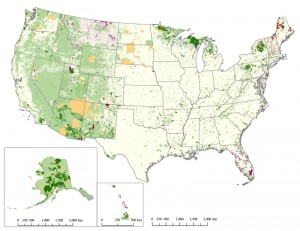- Sudan’s date-gin brewers thrive despite Sharia. There’s date gin? h/t Brendan.
- A very interesting account of virus resistant papayas.
- Whole grains are good for you. And could be better.
- Swiss cow culture.
- Like pocket pigs? You’re gonna love the pocket horse.
New protected areas dataset released into wild
Speaking of mashing up funky GIS datasets with crop wild relatives distribution data — and we do; a lot — how long will it be before someone does it with the new US protected areas database?

Hairy pig hits limelight
They don’t say whether it is the famous Lincolnshire Curly Coat, but it looks like it might be. 1 Now, if only they could make them pocket-sized…
Thanks, Cary.
UPDATE (17 Fe. 2016): Well, “they” were the LA Times, and both the story and video to which we linked back in 2010 are no more. But the “sheep pig” in question probably was the Mangalitza, and the story of how it was rescued from oblivion is actually pretty cool.
Mexico develops its agro-ecotourism offer
Ah, to get lost on the Tequila Trail!
Protecting British food
If you were intrigued by our recent nibble about Yorkshire Forced Rhubarb receiving Protected Designation of Origin (PDO) status by the European Commission, you’ll no doubt be wondering what other examples of British fare share that honour. Well, Paul Mundy just posted a link to a list over at the ELDev Yahoo group. I have only one comment: 10 types of beer and cider seems too few…